With 78,801 photos submitted by 4,738 photographers, the 2019 World Press Photo of the Year Contest can only have winners of the very highest caliber. These hard-hitting images, taken by professional photo-journalists from all over the world, tell us the stories that matter, getting to the heart of the issues facing our world and opening our eyes to the often harsh reality.
This year’s winner is a heartbreaking photo of 2-year-old Honduran toddler Yanela Sanchez, who is captured crying as she and her mother, Sandra Sanchez, are taken into custody by US border officials in McAllen, Texas. The photo, which went viral and sparked a major debate, was taken by Getty Images photographer John Moore, who described the experience in an interview with NPR. “I could see the fear on their faces, in their eyes,” the award-winning photographer said. “As the Border Patrol took people’s names down, I could see a mother holding a young child.”
As Sandra and Yanela were being processed and searched, officers asked the mother to set the child aside. “At that moment, the young child broke into tears, and she started wailing,” Moore said. “I took a knee and had very few frames of that moment before it was over.”
It was an unhappy end to a long an emotional journey for mother and daughter, attempting to make a better life for themselves after their own country of Honduras has descended into poverty and violence, due in no small part to U.S. policies over the years. Moore knew that for the pair, some painful times could lie ahead. “Most of us here had heard the news that the Trump administration had planned to separate families. And these people really had no idea about this news. And it was hard to take these pictures, knowing what was coming next.”
As the immigration debate intensified, the image of the tearful girl was juxtaposed against a stern-looking Donald Trump on the cover of the July 2018 edition of TIME magazine, alongside the caption: Welcome to America. Later on, it emerged that mother and daughter weren’t actually split up on this occasion, leading many to accuse the photo of promoting a false narrative. Moore confirmed to CBS News that the agents he observed that night acted professionally but says he’s still pleased with both the response to his photo and the TIME cover image.
“Oftentimes, immigration is talked about in terms of statistics, and when you put a human face and humanize an issue, you make people feel,” Moore says. “And when you make people feel, they have compassion. And if I’ve done just a little bit of that, then that’s OK.”
Despite the controversy surrounding it, the judges felt that the powerful image was symbolic of the wider issue at hand, and more than merited the award.
Scroll down to see other winners in the prestigious contest, which has been running since 1955, and let us know your favorites in the comments!
Contemporary Issues, Singles, 1st Prize, “The Cubanitas” by Diana Markosian
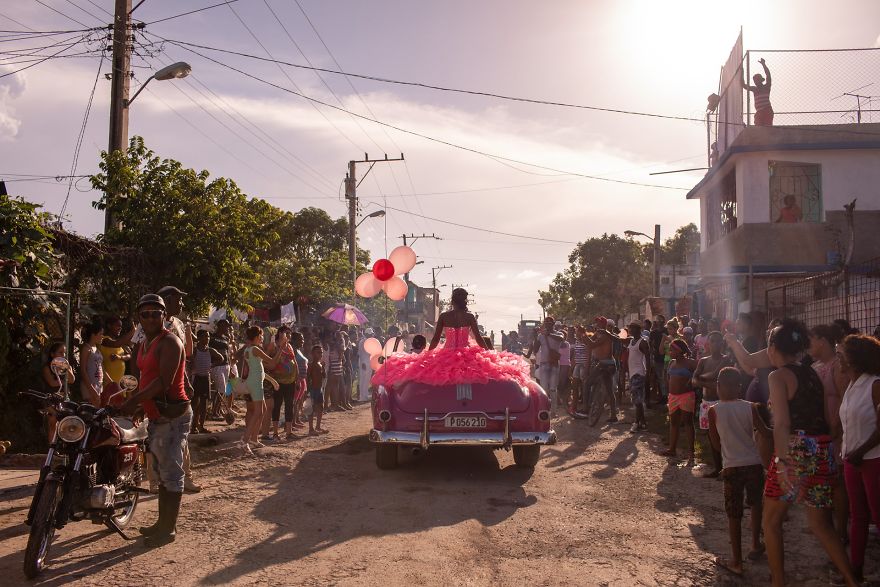
Image credits: Diana Markosian
Pura rides around her neighborhood in a pink 1950s convertible, as the community gathers to celebrate her fifteenth birthday, in Havana, Cuba.
A girl’s quinceañera (fifteenth birthday) is a Latino coming-of-age tradition marking transition into womanhood. It is a gender specific rite of passage, traditionally showcasing a girl’s purity and readiness for marriage. Families go to great expense, often celebrating with a lavish party. The girl dresses as a princess, living out a fantasy and perceived idea of femininity. In Cuba, the tradition has transformed into a performance involving photo and video shoots, often documented in a photobook. Pura’s quinceañera had a special poignancy, as some years earlier, having been diagnosed with a brain tumor, she was told she would not live beyond the age of 13.
Contemporary Issues, Singles, 2nd Prize, “Male Rape” by Mary F. Calvert
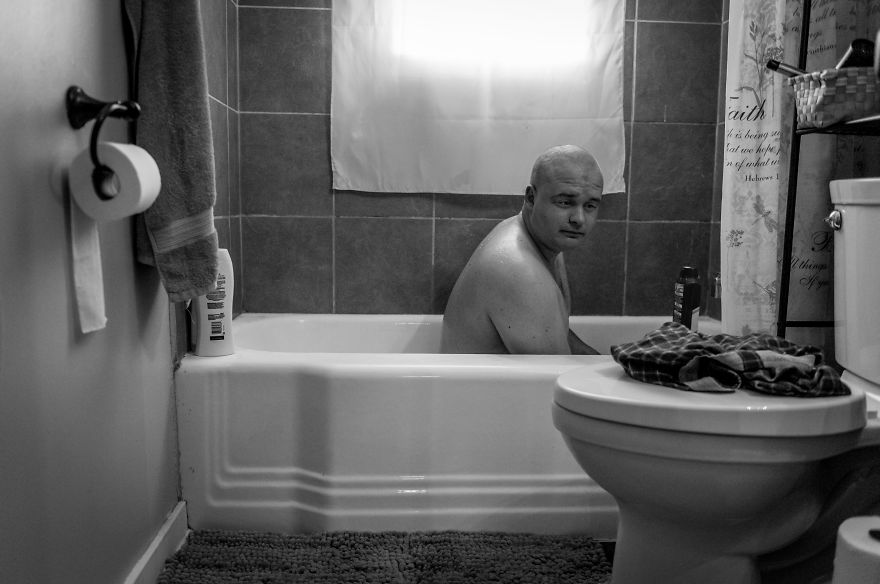
Image credits: Mary F. Calvert
Former US marine Ethan Hanson bathes at home in Austin, Minnesota, USA, after a sexual trauma experienced during his military service left him unable to take showers.
During a boot camp, Ethan and fellow recruits were ordered to walk naked through a communal shower while pressed together. Ethan reported the incident, but was harassed by the other men for doing so. Nightmares and panic attacks later forced him to resign. Recent Defense Department figures show sexual assault in the military to be on the increase. Servicemen are less likely than women to report sexual trauma, fearing retaliation or stigma.
Contemporary Issues, Singles, 3rd Prize, “Afghan Refugees Waiting to Cross the Iranian Border” by Enayat Asadi
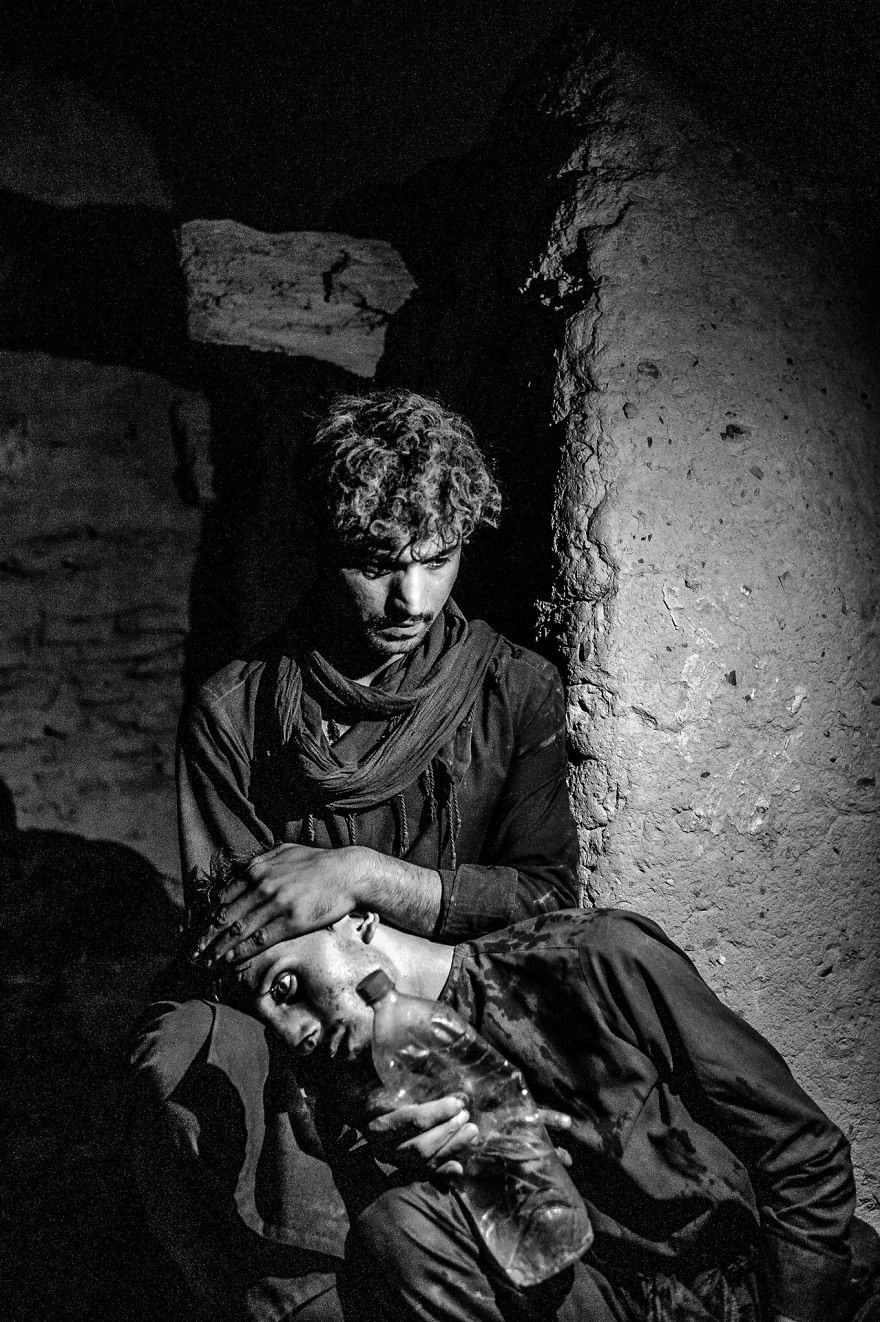
Image credits: Enayat Asadi
An Afghan refugee comforts his companion while waiting for transport across the eastern border of Iran, on 27 July.
UNHCR reports that Iran has almost one million registered refugees, the vast majority from Afghanistan. In addition, more than 1.5 million undocumented Afghans are estimated to be present in the country. Many people fleeing violence, insecurity and poverty in Afghanistan find no alternative but to use illegal traffickers, along routes where they are exposed to robbery, kidnapping and death. Their aim is to pass through Iran and Turkey or Greece to seek a better life elsewhere, but trafficked refugees are highly vulnerable to forced labor, debt bondage, forced marriage, or work in the sex trade.
Contemporary Issues, Stories, 3rd Prize, “Faces of an Epidemic” by Philip Montgomery

Image credits: Philip Montgomery
The body of Brian Malmsbury is taken away after he overdosed on heroin in the basement of his family’s home, Miamisburg, Ohio, USA.
According to the National Institute on Drug Abuse, more than 130 people a day in the US die after overdosing on opioids. President Donald Trump has declared the opioid epidemic a national public health emergency. The crisis has its roots in the 1990s, when pharmaceutical companies assured doctors that opioid pain relievers were not addictive. The firm Purdue Pharma, in particular, has been accused of aggressive marketing even when the effects of opioids were known. Increased prescription of opioids such as Oxycontin led to widespread misuse. Some people switched to heroin, which was cheaper, and later to synthetic opioids, which are more potent and more likely to lead to a fatal overdose.
Contemporary Issues, Stories, 1st Prize, Blessed Be the Fruit: Ireland’s Struggle to Overturn Anti-Abortion Laws” by Olivia Harris
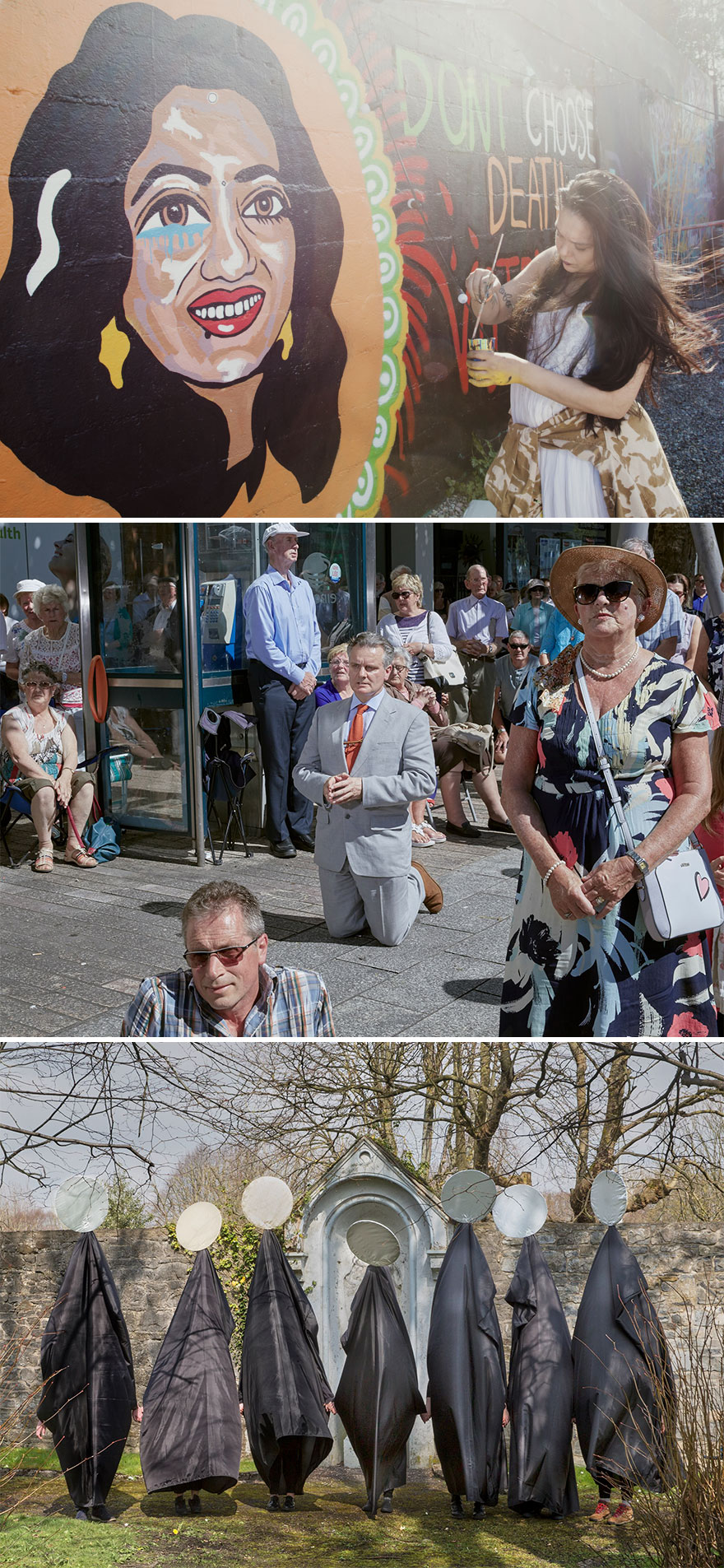
Image credits: Olivia Harris
Graffiti artist Shirani Bolle paints a portrait of Savita Halappanavar, who died in 2012 after being refused an abortion, in Dublin, Ireland.
On 25 May, Ireland voted by a large majority to overturn its abortion laws, which were among the most restrictive in the world. A 1983 referendum had resulted in an Eighth Amendment to the Irish constitution reinforcing a ban on terminations, even those resulting from rape and incest. Prior to the referendum, an estimated 3,000 women traveled to the UK annually for abortions. In 2012, the death of Savita Halappanavar from sepsis after doctors had denied her a termination, shocked Ireland and galvanized campaigners calling for an end to the ban. Her name became synonymous with the movement to repeal the Eighth Amendment. The campaign broadened, arguing that restrictions on women impact everyone in society, and that the support of men, too, was necessary to effect change. Campaigners used social media platforms to spread their message, and took the argument to the streets in the form of demonstrations and theatrical spectacle. Nearly two thirds of the Irish population turned out to participate in the referendum, with 66.4 percent voting to overturn the abortion prohibition. By the end of the year, the Irish president had signed a new bill into law, making abortion for any pregnancy less than 12 weeks available without cost.
Contemporary Issues, Stories, 2nd Prize, “Colombia, (Re)Birth” by Catalina Martin-Chico
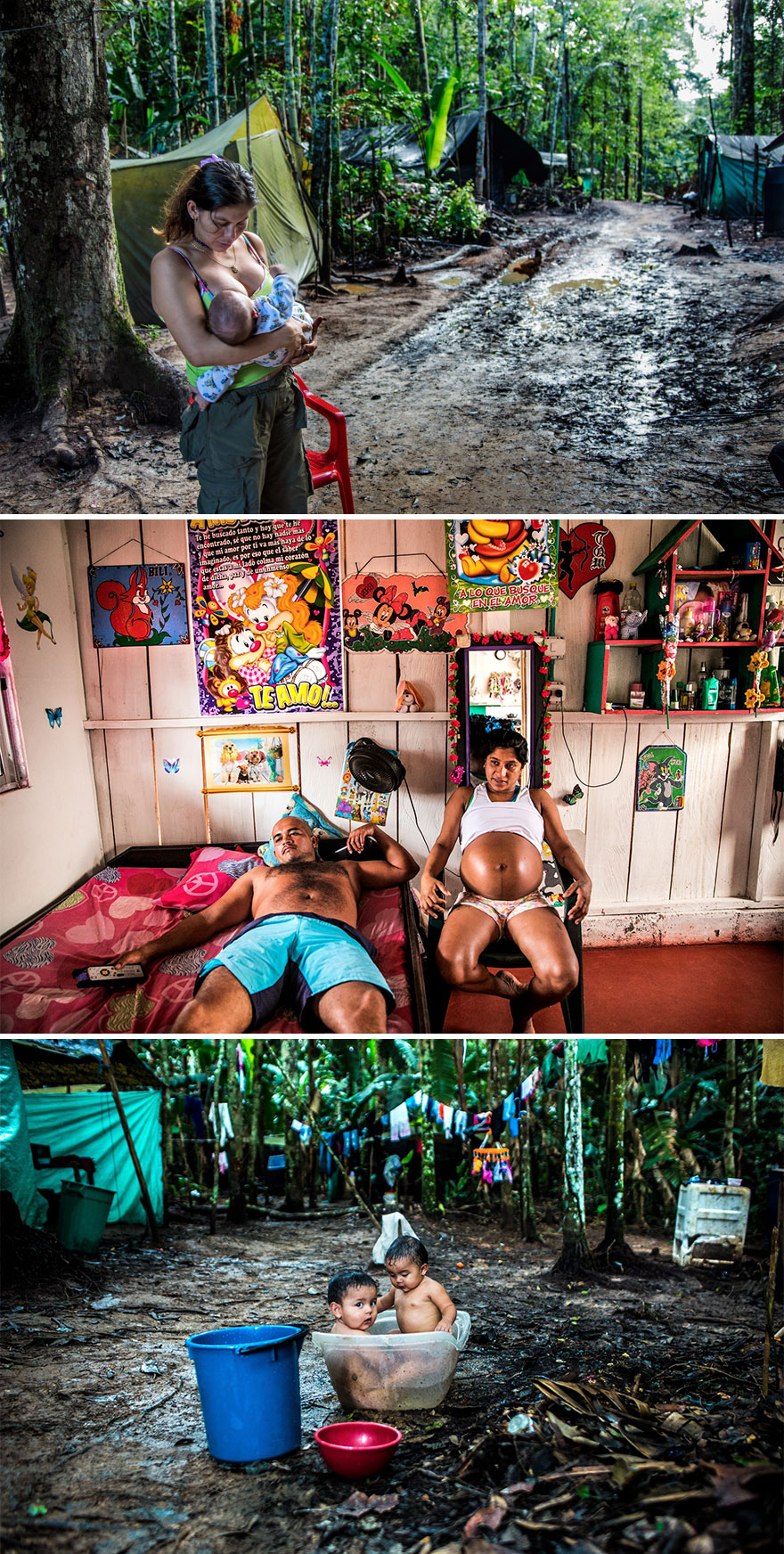
Image credits: Catalina Martin-Chico
Angelina was among the first former guerrillas to become pregnant in the FARC transition camp in San José del Guaviare, Colombia. She joined FARC at the age of 11, calling herself ‘Olga’, after her stepfather had attempted to abuse her.
Since the signing of a peace agreement between the Colombian government and the FARC rebel movement in 2016, there has been a baby boom among former female guerrillas, many living in the demobilization camps set up to help FARC members in the transition back to everyday life. Pregnancy was thought incompatible with guerrilla life. Women were obliged to put war before children, leaving babies with relatives or, some say, undergoing forced abortions—a charge FARC denies.
Environment, Singles, 1st Prize. “Akashinga – the Brave Ones” by Brent Stirton
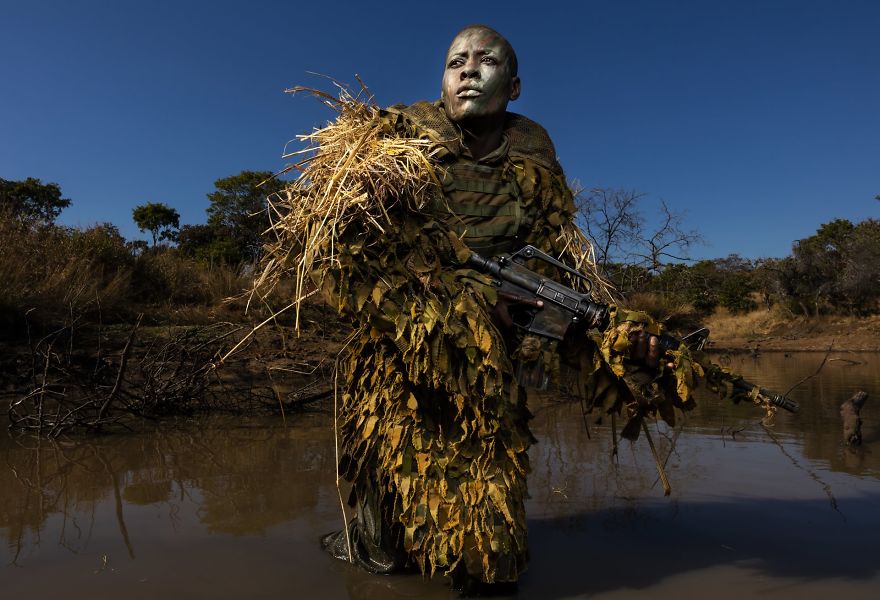
Image credits: Brent Stirton
Petronella Chigumbura (30), a member of an all-female anti-poaching unit called Akashinga, participates in stealth and concealment training in the Phundundu Wildlife Park, Zimbabwe.
Akashinga (‘The Brave Ones’) is a ranger force established as an alternative conservation model. It aims to work with, rather than against local populations, for the long-term benefits of their communities and the environment. Akashinga comprises women from disadvantaged backgrounds, empowering them, offering jobs, and helping local people to benefit directly from the preservation of wildlife. Other strategies—such as using fees from trophy hunting to fund conservation—have been criticized for imposing solutions from the outside and excluding the needs of local people.
Environment, Singles, 2nd Prize, “Evacuated” by Wally Skalij
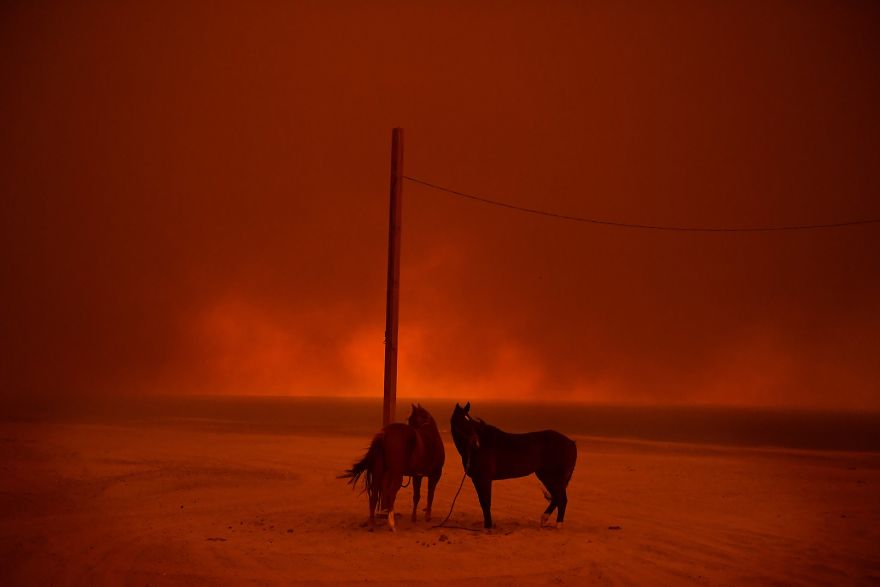
Image credits: Wally Skalij
Evacuated horses stand tied to a pole, as smoke from a wildfire billows above them, on Zuma
Beach, in Malibu, California, USA, on 10 November.
The 2018 wildfire season in California was the deadliest and most destructive on record,
burning an area of more than 676,000 hectares. While scientists pointed to the effects of
climate change as a cause, US President Donald Trump blamed forest management.
Environment, Singles, 3rd Prize, “Living Among What’s Left Behind” by Mário Cruz

Image credits: Mário Cruz
A child who collects recyclable material lies on a mattress surrounded by garbage
floating on the Pasig River, in Manila, Philippines.
The Pasig River was declared biologically dead in the 1990s, due to a combination
of industrial pollution and waste being dumped by nearby communities living without adequate sanitation infrastructure. A 2017 report by Nature Communications cites the Pasig as one of 20 most polluted rivers in the world, with up to 63,700 tons of plastic deposited into the ocean each year. Efforts are being made to clean up the Pasig, which were recognized by an international prize in 2018, but in parts of the river the waste is still so dense that it is possible to walk on top of the garbage.
Environment, Stories, 1st Prize, “The Lake Chad Crisis” by Marco Gualazzini
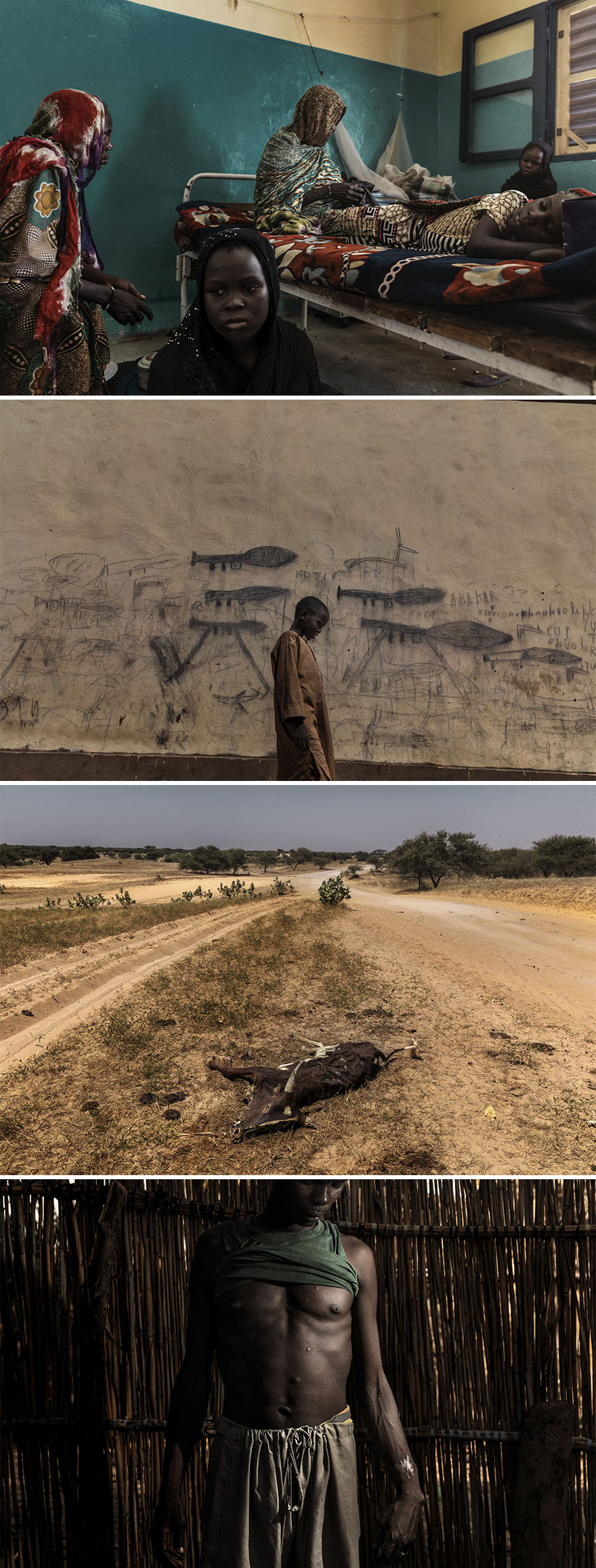
Image credits: Marco Gualazzini
A humanitarian crisis is underway in the Chad Basin, caused by a complex combination of political conflict and environmental factors. Lake Chad—once one of Africa’s largest lakes and a lifeline to 40 million people—is experiencing massive desertification. As a result of unplanned irrigation, extended drought, deforestation and resource mismanagement, the size of the lake has decreased by 90 percent over the past 60 years. Traditional livelihoods such as fishing have withered, and water shortages are causing conflict between farmers and cattle herders. Jihadist group Boko Haram, which is active in the area, both benefits from the hardship and widespread hunger and contributes to it. The group uses local villages as a recruiting ground, and the protracted conflict has uprooted 2.5 million people, exacerbating food insecurity.
Environment, Stories, 2nd Prize, “God’s Honey” by Nadia Shira Cohen
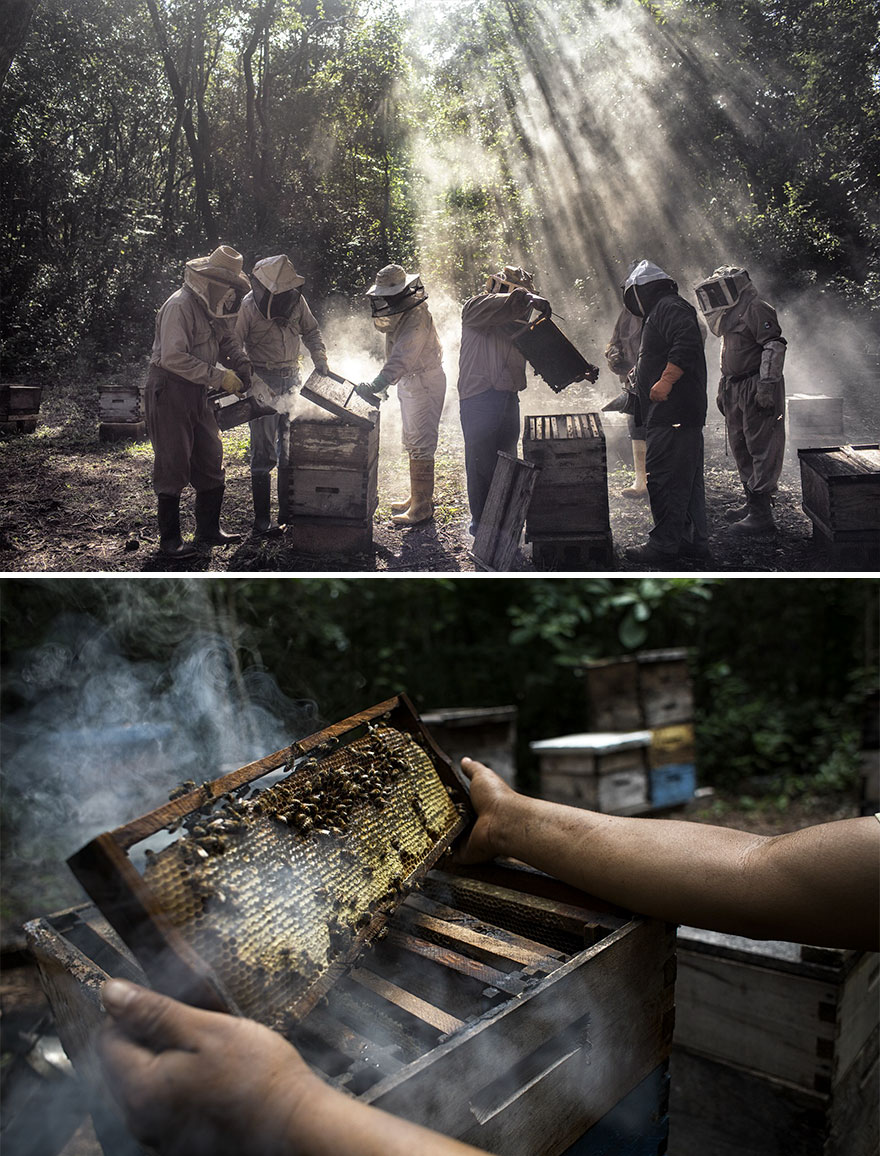
Image credits: Nadia Shira Cohen
Beekeepers, led by Russel Armin Balan, tend their hives in Tinúm, Yucatán, Mexico.
Mennonite farmers growing soy in Campeche, on the Yucatán Peninsula in Mexico, are allegedly adversely impacting the livelihood of local Mayan beekeepers. The Mennonites farm large tracts of land in the area. Environmental groups and honey producers say that the introduction of genetically modified soy and use of the agrochemical glyphosate endangers health, contaminates crops, and reduces the market value of honey by threatening its ‘organic’ label. Soy production also leads to deforestation, as land is increasingly bought for farming, further affecting bee populations.
General News, Singles, 1st Prize, “The Disappearance of Jamal Khashoggi” by Chris McGrath
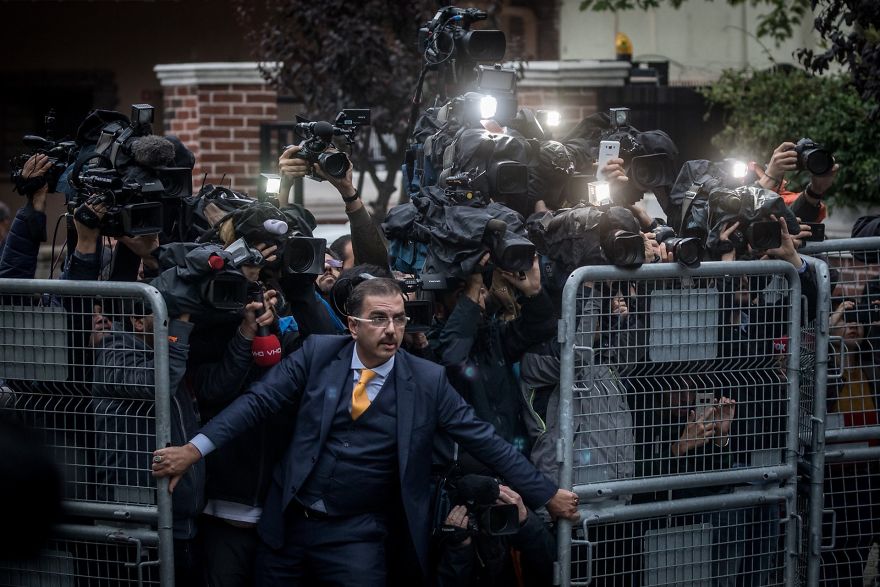
Image credits: Chris McGrath
An unidentified man tries to hold back the press as Saudi investigators arrive at the Saudi Arabian Consulate in Istanbul, Turkey, amid a growing international backlash to the disappearance of journalist Jamal Khashoggi.
A critic of the Saudi regime, Khashoggi had been missing since entering the consulate on 2 October to obtain documents. After weeks of rumor and false information, Riyadh announced that Khashoggi had been killed accidentally during an altercation. Turkish authorities and the CIA claimed he had been murdered by Saudi intelligence operatives, working under high Saudi authority.
General News, Singles, 2nd Prize, “Still Life Volcano” by Daniele Volpe
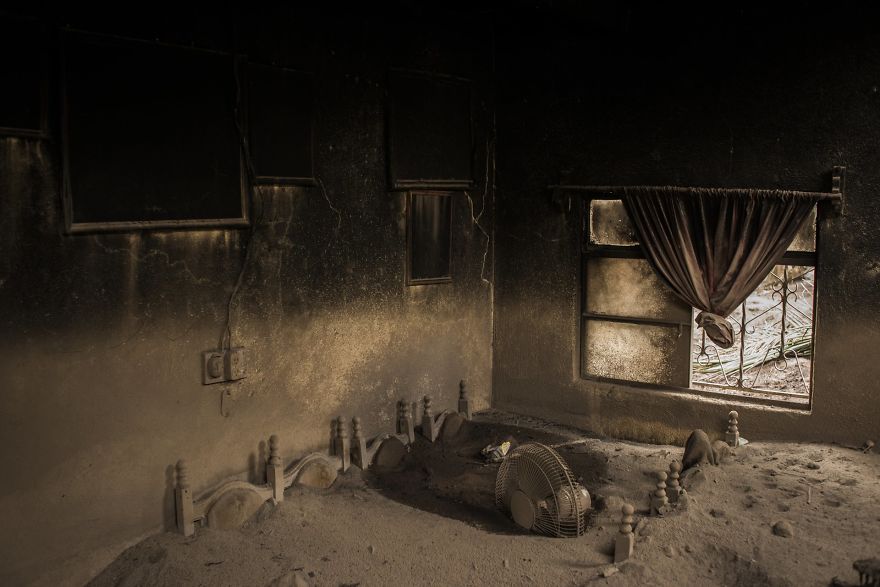
Image credits: Daniele Volpe
The living-room of an abandoned home in San Miguel Los Lotes, Guatemala, lies covered in ash after the eruption of Volcán de Fuego on 3 June.
Fuego, around 40 km southwest of the capital Guatemala City, is one of Latin America’s most active volcanoes, and has been erupting periodically since 2002. It is monitored by volcanologists, but this eruption came without warning. People living around the volcano, many at Sunday lunch, were surprised by the suddenness of the event, as Fuego spewed red-hot lava, ash, poisonous gases and flaming debris onto villages below. The eruption was one of the deadliest in Guatemala for over a century. Guatemala’s National Institute of Forensic Sciences reported the recovery of 318 bodies, over a third of them unidentified.
General News, Singles, 3rd Prize, “Unilateral” by Brendan Smialowski
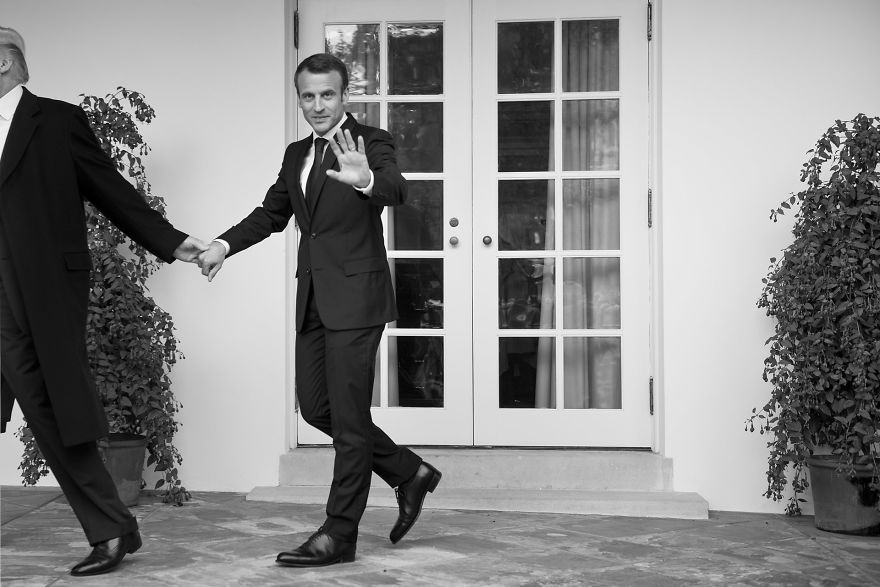
Image credits: Brendan Smialowski
US President Donald Trump leads France’s President Emmanuel Macron by the hand while walking to the Oval Office of the White House, in Washington DC.
President Macron’s three-day visit to the United States was the first official state visit of the Trump administration. Unexpectedly, the two presidents’ body language went beyond the norm for such visits, bordering on the intimate. The leaders also praised each other effusively. The 2015 international nuclear agreement with Iran was one of the main topics under discussion. Macron aimed to persuade Trump to adhere to the deal, which limited Iran’s nuclear program in return for a lifting of sanctions, but failed. On 8 May, President Trump withdrew from the agreement, breaking with European allies. The relationship between the two leaders appears to have soured, with Trump later attacking Macron on Twitter.
General News, Stories, 1st Prize, “Yemen Crisis” by Lorenzo Tugnoli
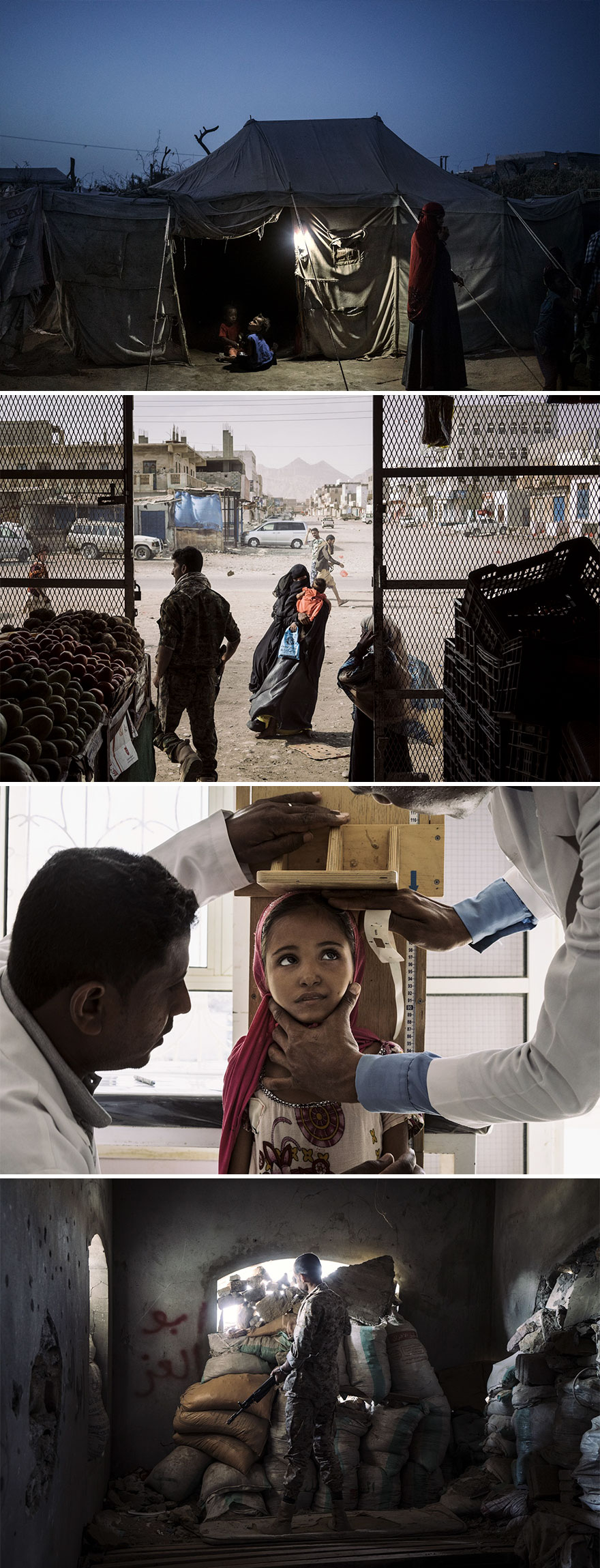
Image credits: Lorenzo Tugnoli
After nearly four years of conflict in Yemen, at least 8.4 million people are at risk of starvation and 22 million people—75% of the population—are in need of humanitarian assistance, according to the UN. In 2014, Houthi Shia Muslim rebels seized northern areas of the country, forcing the president, Abdrabbuh Mansour Hadi, into exile. The conflict spread, and escalated when Saudi Arabia, in coalition with eight other mostly Sunni Arab states, began air strikes against the Houthis. By 2018, the war had led to what the UN termed the world’s worst man-made humanitarian disaster. Saudi Arabia said that Iran—a Shia-majority state and their rival regional power—was backing the Houthis with weapons and supplies, a charge Iran denied. The Saudi-led coalition implemented a blockade on Yemen, imposing import restrictions on food, medicines and fuel. Resulting shortages exacerbated the humanitarian crisis. In many cases, conditions of near-famine were caused not so much by the unavailability of food, but because it became unaffordable, priced out of reach to most Yemenis by import restrictions, soaring transport costs due to fuel scarcity, a collapsing currency and other man-made supply disruptions.
General News, Stories, 2nd Prize, “A Fight for Democracy” by John Wessels
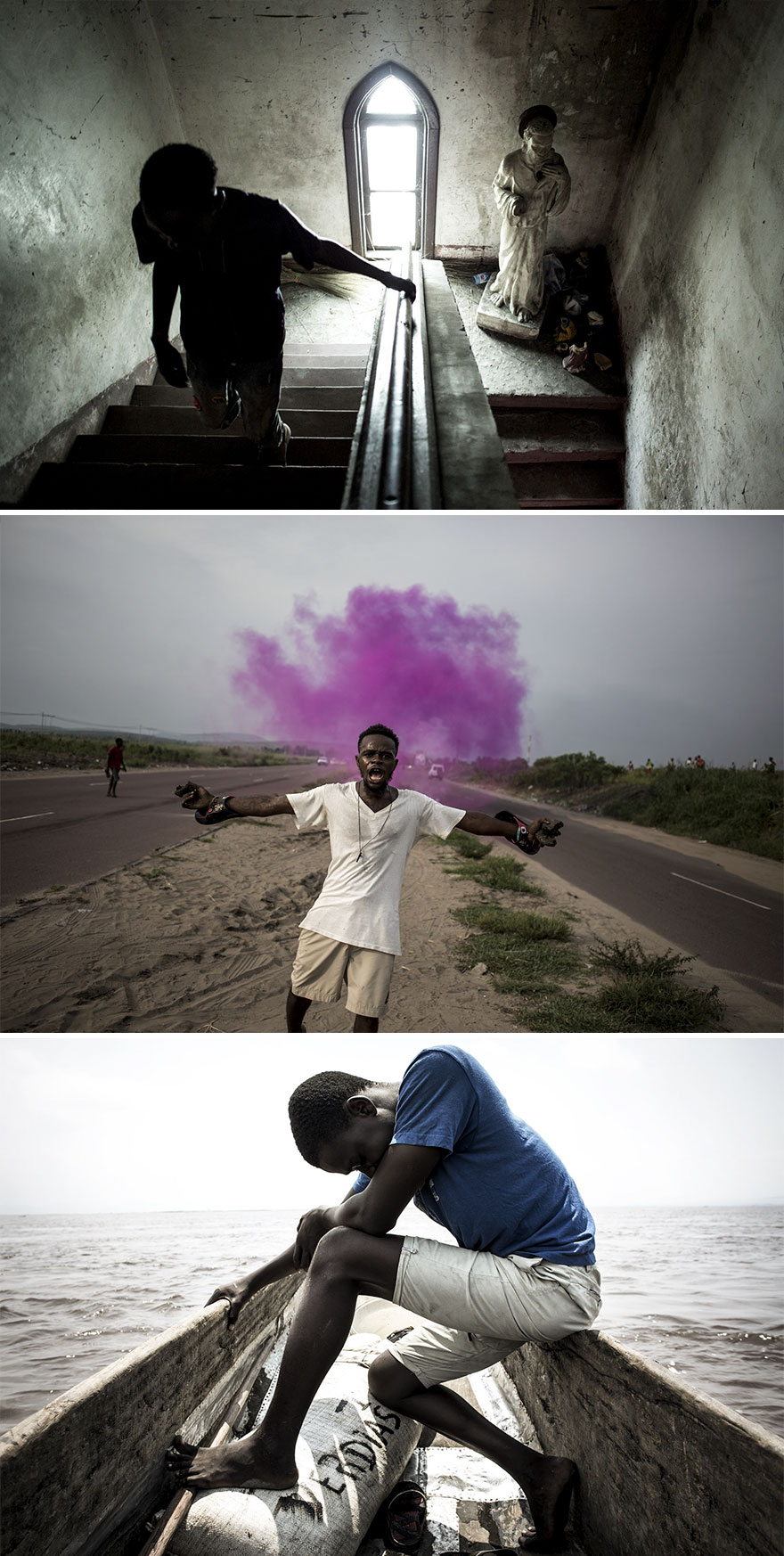
Image credits: John Wessels
Long-delayed general elections to find a successor to President Joseph Kabila in the Democratic Republic of Congo (DRC), were finally held on 30 December. The run-up was marked by protests, street rallies and clashes between opposition supporters and police. Elections had been repeatedly postponed since President Kabila’s mandate expired in 2016. The election was won by Felix Tshisekedi, leader of DRC’s largest opposition party, the Union for Democracy and Social Progress (UDPS). The result was disputed by rival parties, but welcomed internationally as the first peaceful transfer of power since Congo’s independence in 1960.
General News, Stories, 3rd Prize, “Fighting Ebola and Conflict” by John Wessels

Image credits: John Wessels
Beni, in northeastern Democratic Republic of Congo (DRC), has been affected by conflict for over 25 years, and in 2018 had also to deal with a major outbreak of the deadly Ebola virus. Over 100 armed groups are estimated to be active in the region, with government troops backed by MONUSCO, a UN stabilization mission, battling with the Allied Democratic Forces (ADF) and other rebel groups. Attacks in and around the town spiked during the Ebola epidemic, which Médecins Sans Frontières (MSF) called the second-largest recorded anywhere.The Ebola outbreak was first declared on 1 August, in the small town of Mangina, 30 km from Beni, and soon spread. By the end of the year, some 700 cases and over 460 deaths had been reported. Containing the highly contagious disease was almost impossible in a conflict situation. Widespread displacement made containing and tracking cases complicated and meant some stricken areas were difficult to access. Medical teams’ operations were disrupted, and misinformation about the disease was rife.
Long-Term Projects, Stories, 1st Prize, “Beckon Us From Home” by Sarah Blesener

Image credits: Sarah Blesener
Patriotic education, often with a military subtext, forms the mainspring of many youth programs in both Russia and the United States. In America, the dual messages of ‘America first’ and ‘Americanism’ can be found not only as a driving force behind adult political movements, but around the country in camps and clubs where young people are taught what it means to be an American. In Russia, patriotic clubs and camps are encouraged by government. In 2015, President Vladimir Putin ordered the creation of a Russian students’ movement whose aim was to help form the characters of young people through instruction in ideology, religion and preparedness for war. The ‘Patriotic Education of Russian Citizens in 2016–2020’ program called for an 8 percent increase in patriotism among youth, and a 10 percent increase in recruits to the armed forces.
The photographer visited ten youth programs in the US, as well as schools and military summer camps in Russia. The aim of the series is to use these young people and their lives as the focal point in an open dialogue around the ideas instilled in future generations, and examine how young people are responding to contemporary society.
Long-Term Projects, Stories, 2nd Prize, “The House That Bleeds” by Yael Martínez
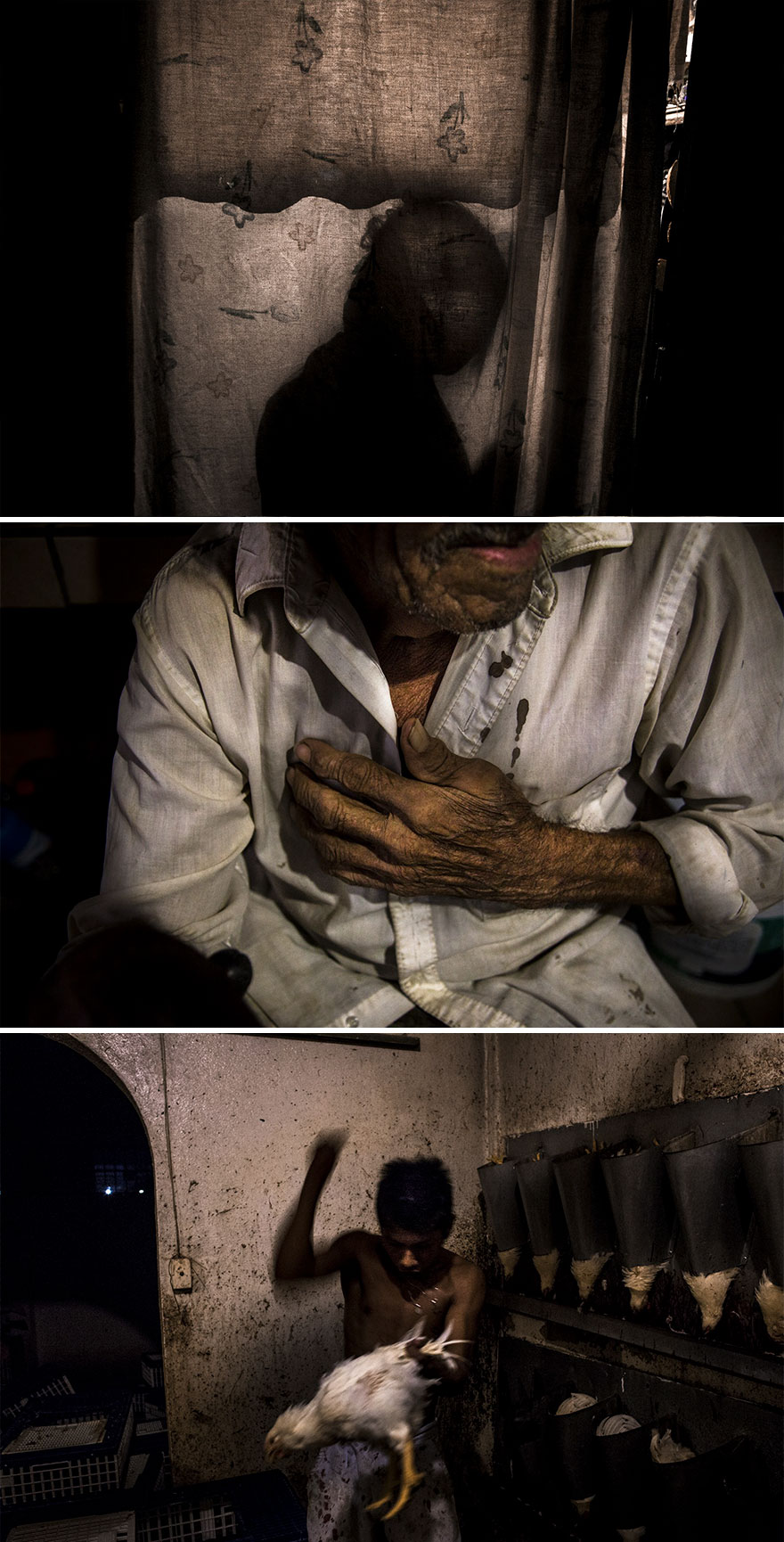
Image credits: Yael Martínez
Across Mexico, more than 37,400 people have been categorized as ‘missing’ by official sources. The vast majority of those are believed to be dead—victims of ongoing violence that has claimed more than 250,000 lives since 2006. These disappearances are the source of lasting psychological trauma for families left behind.
The violence has its roots in the war on Mexico’s powerful drugs cartels instigated by President Felipe Calderón during his 2006–2012 term of office, and continued by his successor, Enrique Peña Nieto. The ensuing violence has led to a catastrophic rise in murder rates and in the number of unsolved disappearances, which is aided by corruption and impunity. President Nieto promised an end to violence, but although homicides declined, authorities seemed unable to restore the rule of law or make much progress in the struggle against cartels. Among the states most affected are Sinaloa and Guerrero, which was included in a list of no-travel zones by the US government in 2018.
In 2013, one of the photographer’s brothers-in-law was killed and another two disappeared. This led him to begin documenting the resultant psychological and emotional fracture in his own family and in the families of other missing people, to give a personal account of the despair and sense of absence that accrues over time.
Nature, Singles, 1st Prize, “Harvesting Frogs’ Legs” by Bence Máté
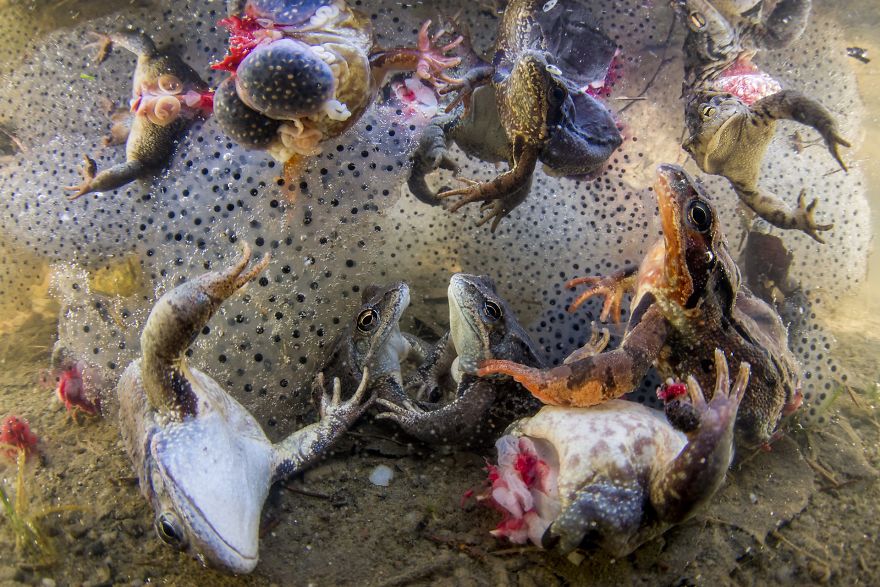
Image credits: Bence Máté
Frogs with their legs severed and surrounded by frogspawn struggle to the surface, after being thrown back into the water in Covasna, Eastern Carpathians, Romania, in April.
Frogs’ legs are frequently harvested for food in the spring, when males and females gather to mate and spawn. Legs are sometimes severed while the animal is still living. About US$40 million worth are sold annually, with countries across the world participating in the trade. A small part of the population in the Carpathian Mountains make their living by collecting frogs’ legs in the wild and selling them.
Nature, Singles, 2nd Prize, “Flamingo Socks” by v
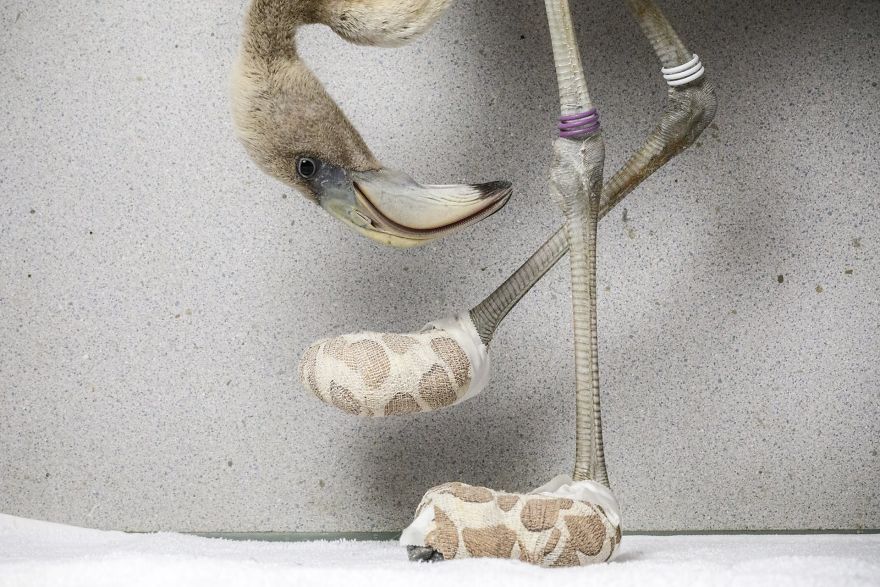
Image credits: Jasper Doest
Caribbean flamingo inspects the improvised socks created to help heal its severe foot lesions, at the Fundashon Dier en Onderwijs Cariben, Curaçao.
The bird was brought by plane from neighboring island Bonaire, after spending a few weeks in a local rehabilitation facility. Such lesions are common among captive flamingos, as they have very sensitive feet and are used to walking on soft ground. After a few weeks of care the bird was transported back to Bonaire. There are around 3,000 breeding pairs of Caribbean flamingos on Bonaire, and a further 200 to 300 birds on Curaçao.
Nature, Singles, 3rd Prize, “Glass Butterfly” by Angel Fitor
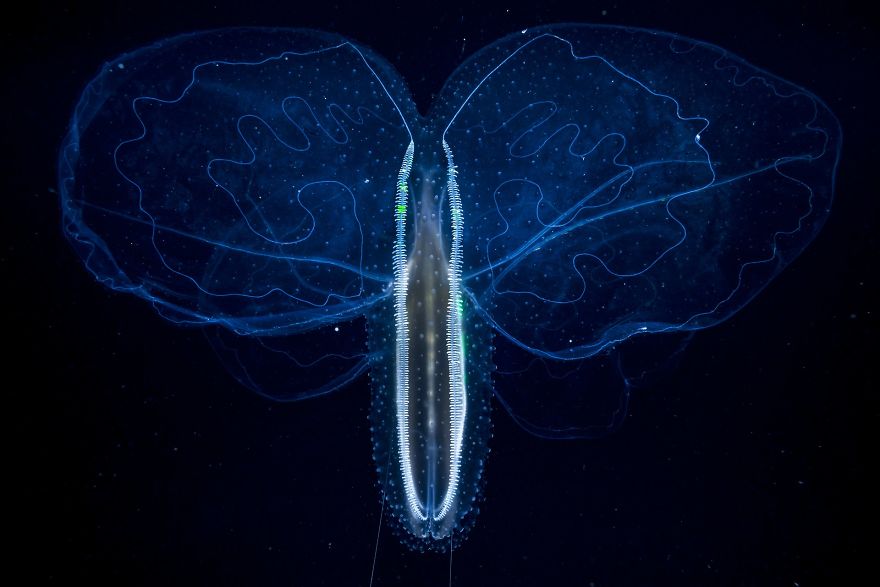
Image credits: Angel Fitor
A winged comb jelly, Leucothea multicornis, its wings widely opened, propels itself through
waters off Alicante, Spain.
Leucothea multicornis, like other comb jellies, is a voracious predator, capturing its prey
using sticky cells rather than by stinging. Little is currently known about the biology of comb
jellies. Because the creatures are so fragile and fold their wings in reaction to the slightest
vibration, they are extremely difficult to study and to photograph.
Nature, Stories, 1st Prize, “Falcons and the Arab Influence” by Brent Stirton
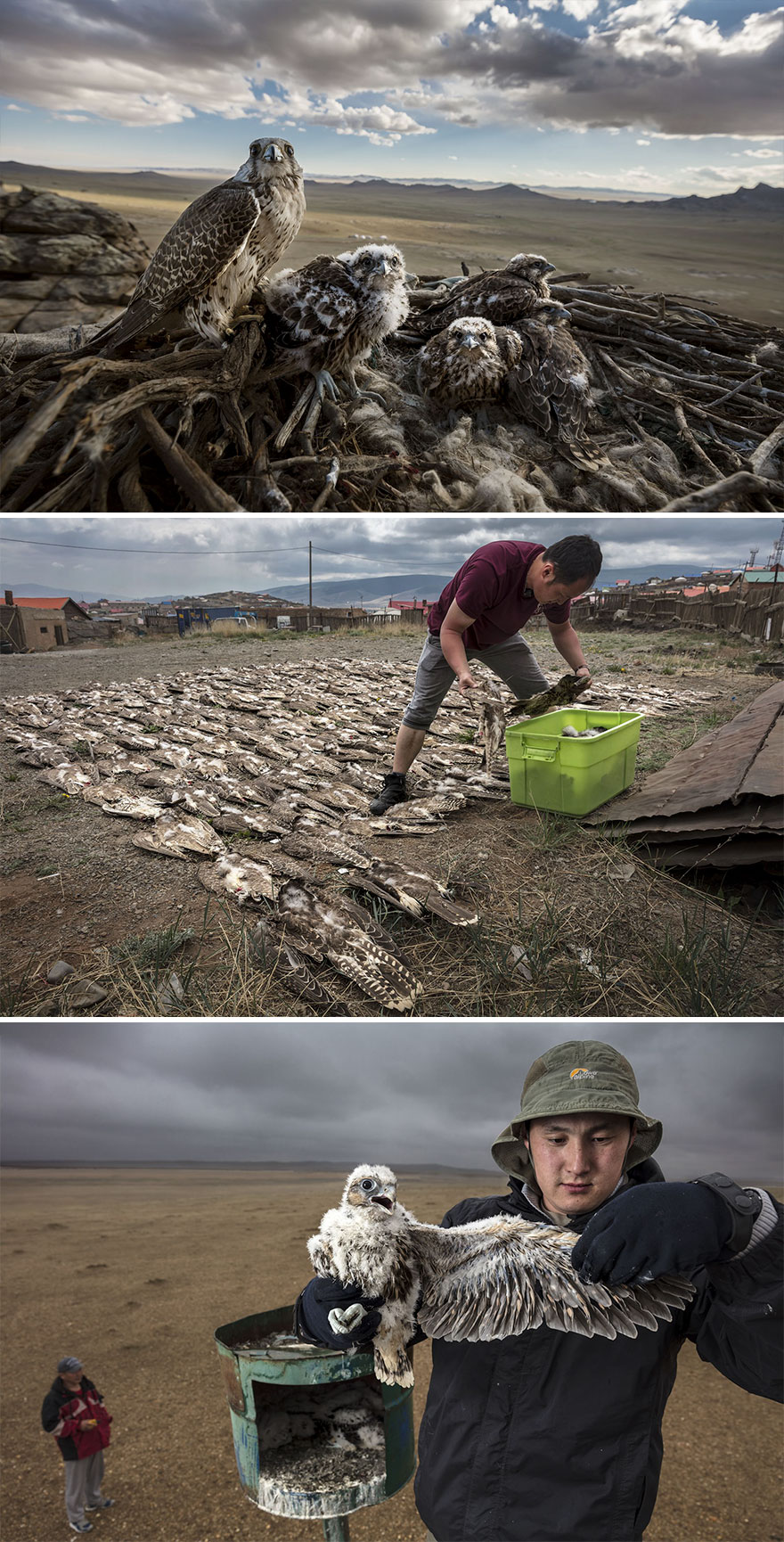
Image credits: Brent Stirton
The millennia-old practice of falconry is experiencing an international resurgence, especially as a result of efforts in the Arab world. UNESCO now recognises falconry as an Intangible Cultural Heritage of Humanity (ICH), a status enjoyed by no other hunting sport. Falcons bred in captivity have helped diminish the trade in captured wild birds, including some species that are listed as endangered. But some falcons in the wild continue to be at risk from capture and other anthropogenic factors such as electrocution on badly designed powerlines, habitat degradation and agrochemicals. Similarly, although the breeding of birds such as houbara bustards for prey has made hunting a more sustainable practice, the British Ornithologists’ Union reported that the wild houbara population continued to decline
Nature, Stories, 2nd Prize, “Meet Bob” by Jasper Doest
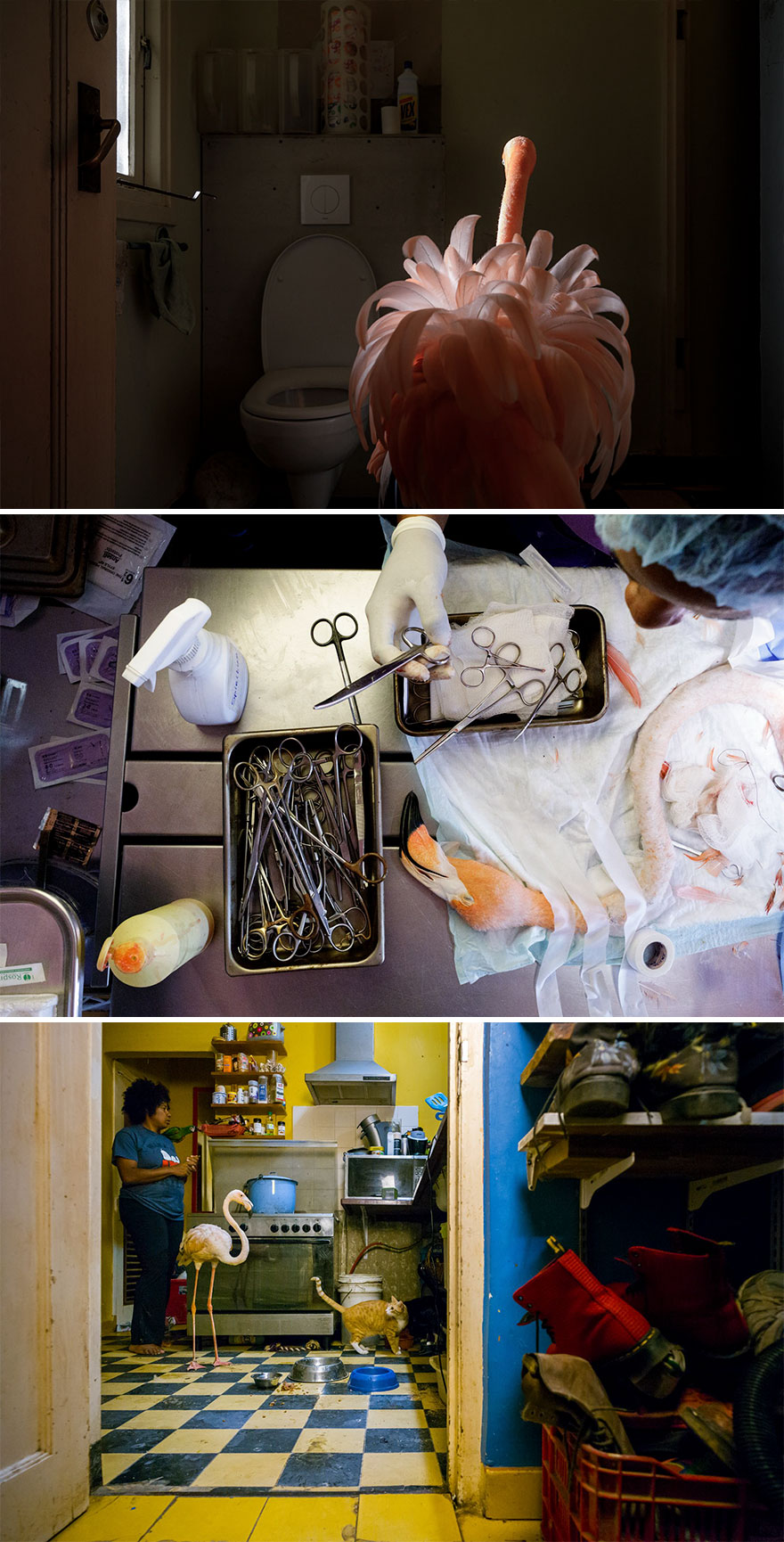
Image credits: Jasper Doest
Bob, a rescued Caribbean flamingo, lives among humans on the Dutch island of Curaçao. Bob was badly injured when he flew into a hotel window, and was cared for by Odette Doest who runs Fundashon Dier en Onderwijs Cariben (FDOC), a wildlife rehabilitation center. During Bob’s rehabilitation, Odette discovered that he had been habituated to humans, and so would not survive if returned to the wild. Instead, he became an ‘ambassador’ for FDOC, which educates local people about the importance of protecting the island’s wildl
Nature, Stories, 3rd Prize, “Wild Pumas of Patagonia” by Ingo Arndt
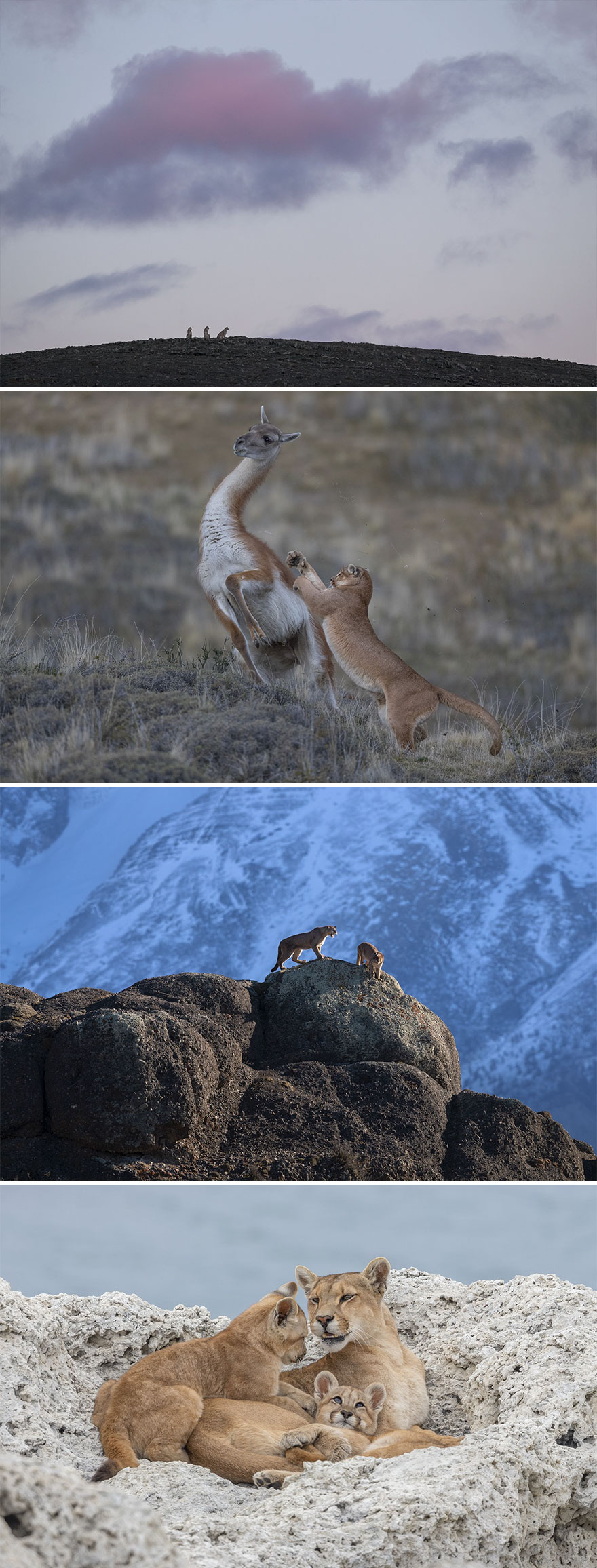
Image credits: Ingo Arndt
Pumas, also known as mountain lions or cougars, are found from the Canadian Yukon to the southern Andes, the widest range of any large wild mammal in the Western Hemisphere. They can survive in a variety of habitats, from deserts and prairies to forests and snowy mountains, but are generally shy and elusive to humans. The Torres del Paine region in Chilean Patagonia is thought to contain higher concentrations of pumas than anywhere else in the world. Pumas are ambush predators, stalking their prey from a distance for an hour or more before attacking. In Torres del Paine, pumas feed mainly on guanacos, which are closely related to llamas.
Portraits, Singles, 1st Prize, “Dakar Fashion” by Finbarr O’Reilly
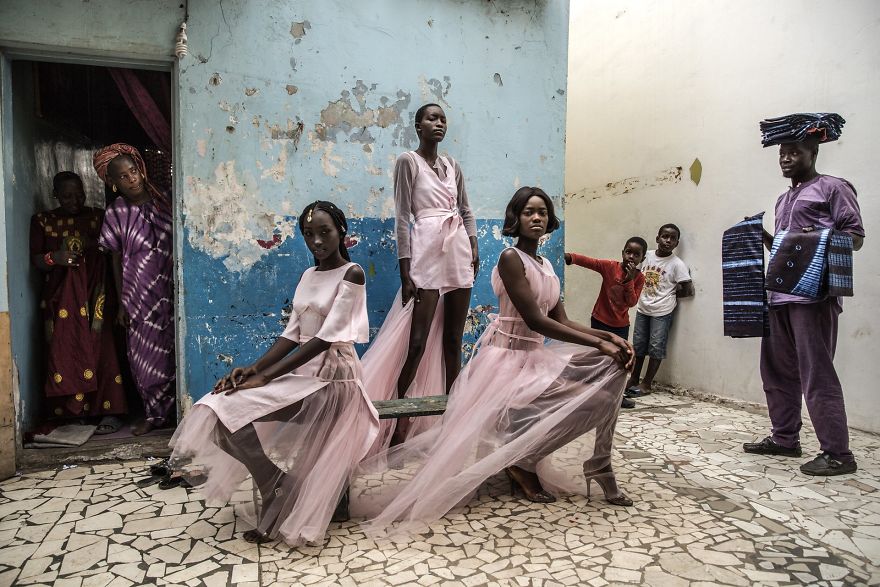
Image credits: Finbarr O’Reilly
Diarra Ndiaye, Ndeye Fatou Mbaye and Mariza Sakho model outfits by designer Adama Paris, in the Medina neighborhood of the Senegalese capital, Dakar, as curious residents look on.
Dakar is a growing hub of Franco-African fashion, and is home to Fashion Africa TV, the first station entirely dedicated to fashion on the continent. The annual Dakar Fashion Week includes an extravagant street show that is open to all and attended by thousands from all corners of the capital. Adama Paris (who has a namesake brand) is a driving force behind the fashion week, and much else on the design sce
Portraits, Singles, 2nd Prize, “Black Birds” by Heba Khamis
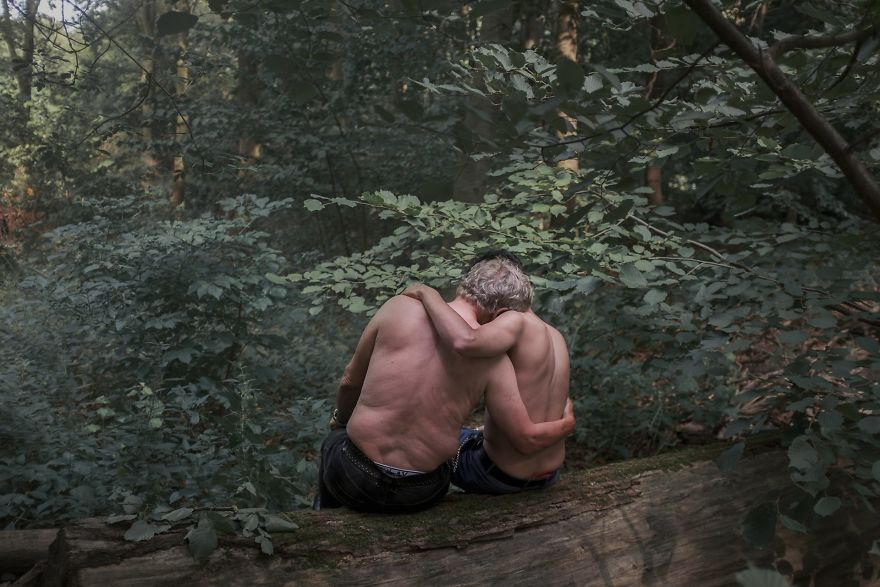
Image credits: Heba Khamis
Jochen (71) and Mohamed (21; not their real names) sit in the Tiergarten, Berlin. Jochen fell in love after meeting Mohamed, then a sex worker in the park. They have been dating for 19 months.
Prostitution between consenting adults is legal in Germany, and German aid charities have reported a marked increase in the number of young migrants turning to sex work. While they wait for their documents, refugees are not allowed to work legally or attend school. The German government prioritizes assistance to refugees from countries with an ongoing war; those seeking asylum from countries without war are placed in a second category, where papers take longer to complete. This lack of employment opportunity creates a severe lack of choice for many, with some young men becoming sex workers, sometimes to fund a heroin addiction. The Tiergarten, a large park in central Berlin, is a popular meeting spot for male sex workers and older clients. Mohamed now works in a gay bar, and is quitting heroin. He is not gay, and Jochen knows that, but being with Jochen was one of the less harmful options he had in life.
Portraits, Singles, 3rd Prize, “When I Was Ill” by Alyona Kochetkova
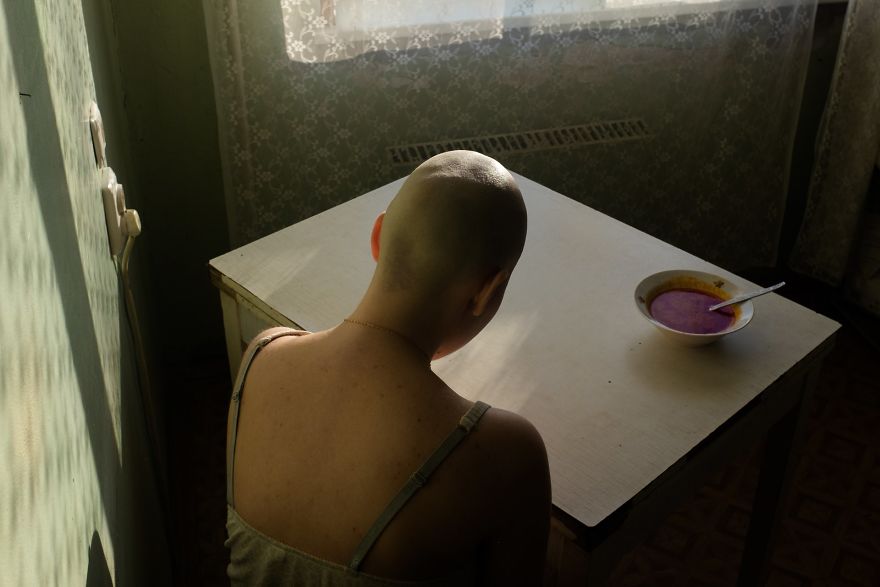
Image credits: Alyona Kochetkova
Alyona Kochetkova sits at home, unable to face borscht (beet soup), her favorite food, during treatment for cancer.
Alyona shot this self-portrait following surgery and chemotherapy, when, although she knew the vital importance of food, she struggled to eat. Taking photos was not only a way of sharing a difficult and personal story in the hope that it might support others with a cancer diagnosis, it was also a means of accepting her ordeal by doing what she loved.
Portraits, Stories, 1st Prize, “Land of Ibeji” by Bénédicte Kurzen and Sanne de Wilde

Image credits: Bénédicte Kurzen and Sanne de Wilde
Nigeria has one of the highest occurrences of twins in the world, particularly among the Yoruba people in the southwest. In the southwestern town of Igbo-Ora, dubbed ‘The Nation’s Home of Twins’, reportedly almost every family has at least one set. In 2018, the town hosted a Twins Festival, attended by over 2,000 pairs. The first-born twin is usually called Taiwo, meaning ‘having the first taste of the world’, while the second-born is named Kehinde, ‘arriving after the other’. Communities have developed different cultural practices in response to this high birth rate, from veneration to demonization. In earlier times, twins in some regions were considered evil, and vilified or killed at birth. Nowadays, the arrival of twins is generally met with celebration, and many think they bring good luck and wealth. Two color filters were used, to express duality: of identity, of photographers, and of attitude to twins.
Portraits, Stories, 2nd Prize, “Northwest Passages” by Jessica Dimmock

Image credits: Jessica Dimmock
Transgender individuals around the world are still exposed to widespread social stigma and abuse. For many transgender women, coming to terms with their female selves is an ongoing process. Some find resourceful ways in which to express their identities in private. Senior transgender women in northwestern USA are pictured in the places where they hid their female identities for decades.
Portraits, Stories, 3rd Prize, “Falleras” by Luisa Dörr

Image credits: Luisa Dörr
Women and girls wear fallera dresses for the Fallas de Valencia festival in Valencia, Spain. Inspired by clothes worn centuries ago by women working in rice fields around the city, the dresses have changed over time and are now elaborate creations that can cost in excess of €1,000. Made mainly of lace and silk, fallera dresses are worn by anyone who wants to take part in what is one of Spain’s biggest street festivals. To complement the gown, falleras set their hair in a traditional three-bun style adorned with ornate combs and jewellery, often handed down through generations. Different parts of the city each have a fallera mayor (and maybe also a young fallera mayor infantil)—a woman who represents her falla (neighborhood group) at the festivities. It is an honor to be chosen, and can mean even greater expense being lavished on the outfit.
Sports, Singles, 1st Prize, “Boxing in Katanga” by John T. Pedersen
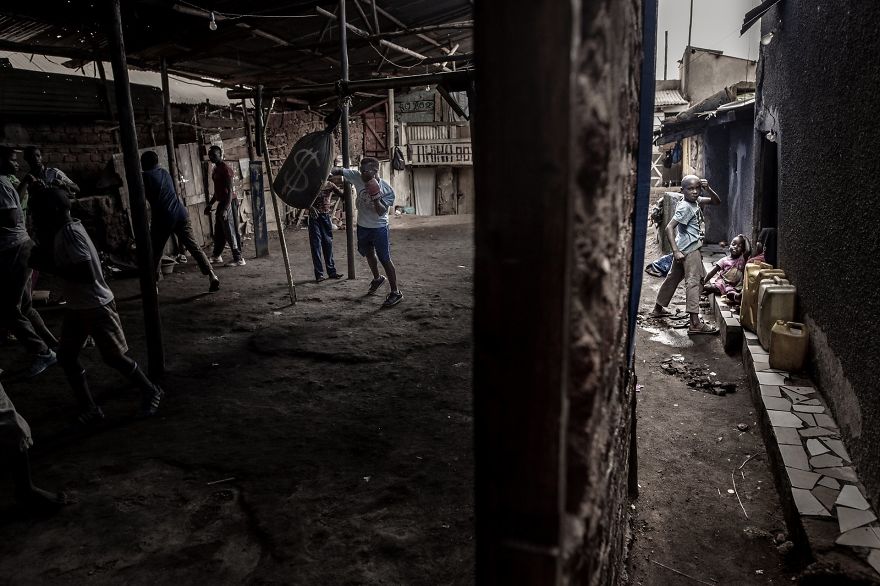
Image credits: John T. Pedersen
Boxer Moreen Ajambo (30) trains at the Rhino boxing club in Katanga, a large slum settlement in Kampala, Uganda, on 24 March.
More than 20,000 people live in Katanga, crowded together and often in extreme poverty. The boxing club receives no outside funding. Ajambo, a mother of seven, boxes in the Ugandan women’s team. Men’s boxing has a long history in Uganda, but women boxers are often frustrated by the few opportunities to compete at an international level.
Sports, Singles, 2nd Prize, “Sunlight Serve” by David Gray
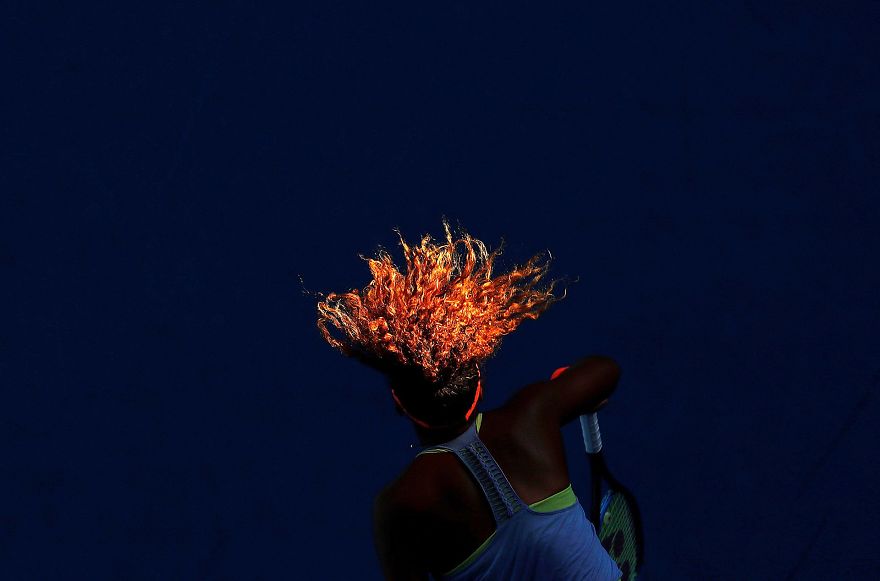
Image credits: David Gray
Naomi Osaka serves during her match against Simona Halep from Romania during the Australian Open tennis tournament, at Margaret Court Arena, Melbourne, Australia, on 22 January.
Osaka, representing Japan, went on to win the tournament. In September, she won the US Open women’s singles, defeating Serena Williams. Over the course of 2018, Osaka rose from number 72 in world rankings to number one.
Sports, Singles, 3rd Prize, “Shields Strikes Back” by Terrell Groggins
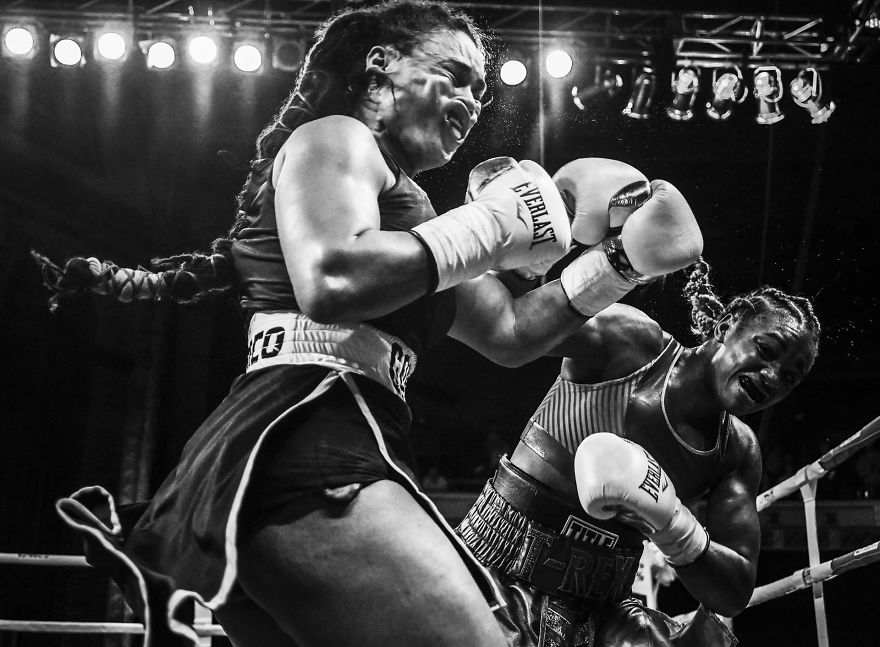
Image credits: www.worldpressphoto.org
Olympic champion Claressa Shields (right) meets Hanna Gabriels in a boxing match at the Masonic Temple in Detroit, Michigan, USA, on 22 June.
Shields suffered a first-round knock-down by Gabriels—the first in her career—but went on to win the match by unanimous decision. Shields is the first American woman to win an Olympic gold medal in boxing, and the first (male or female) to win a gold back-to-back in successive Olympic Games. She has had only one loss in her career, against British World Champion Savannah Marshall, in 2012.
Sports, Stories, 1st Prize, “Crying for Freedom” by Forough Alaei

Image credits: Forough Alaei
In Iran, there are restrictions on female fans entering football stadiums. As football is the nation’s most popular sport, the ban has been a controversial public issue. On 1 March 2018, FIFA president Gianni Infantino met with the president of Iran, Hassan Rouhani, to address the issue. Social-media groups also put the president under pressure, and on 20 June a ruling allowed Tehran’s Azadi Stadium to admit selected groups of women for international matches.The concession to women fans applied only to international matches, and after a senior judicial officer objected in October, it was withdrawn. On 10 November, the FIFA president, who was attending the AFC Cup match in Tehran, asked to be shown that women were being allowed to attend. A selection of women was permitted to enter, though many others were barred.
Sports, Stories, 2nd Prize, “Never Saw Him Cry” by Michael Hanke

Image credits: Michael Hanke
Zdenĕk Šafránek is the captain of the Czech Republic Para Ice Hockey team, and has participated in three Paralympic Games. He has been in a wheelchair since an accident at work in an auto repair shop in 2003. He also represents his country in mountain biking and handcycling, and in 2017–18 was the Czech Republic’s champion paraboxer. Šafránek lives in the town of Pátek, near Podĕbrady, in the Czech Republic, with his partner and three children.
Sports, Stories, 3rd Prize, “Kirkpinar Oil Wrestling Festival” by Elif Ozturk Ozgoncu

Image credits: Elif Ozturk Ozgoncu
Kirkpinar is a Turkish oil-wrestling tournament dating back over 660 years. It is held annually over three days, usually in July, near Edirne, a city in the northwest of the country. Wrestlers (‘pehlivan’) wearing leather breeches (‘kispet’) compete on grass, after being covered with oil. They fight for the title of Chief Pehlivan and a belt made of 1,450 grams of gold. Matches can sometimes last several hours and are won when a wrestler pins another to the ground, or lifts him over his head.
Spot News, Singles, 1st Prize, “Crying Girl on the Border” by John Moore
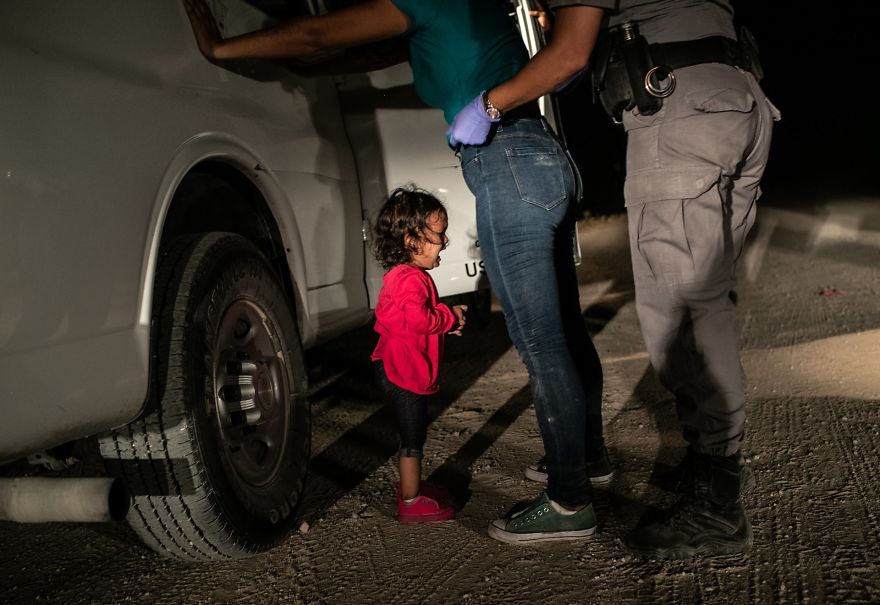
Image credits: John Moore
Immigrant families had rafted across the Rio Grande from Mexico and were then detained by US authorities. Sandra Sanchez said that she and her daughter had been traveling for a month through Central America and Mexico before reaching the US to seek asylum. The Trump Administration had announced a ‘zero tolerance’ policy at the border under which immigrants caught entering the US could be criminally prosecuted. As a result, many apprehended parents were separated from their children, often sent to different detention facilities. After this picture was published worldwide, US Customs and Border Protection confirmed that Yanela and her mother had not been among the thousands who had been separated by US officials. Nevertheless, public outcry over the controversial practice resulted in President Donald Trump reversing the policy on 20 June.
Spot News, Singles, 2nd Prize, “The Death of Michael Nadayo” by Ezra Acayan
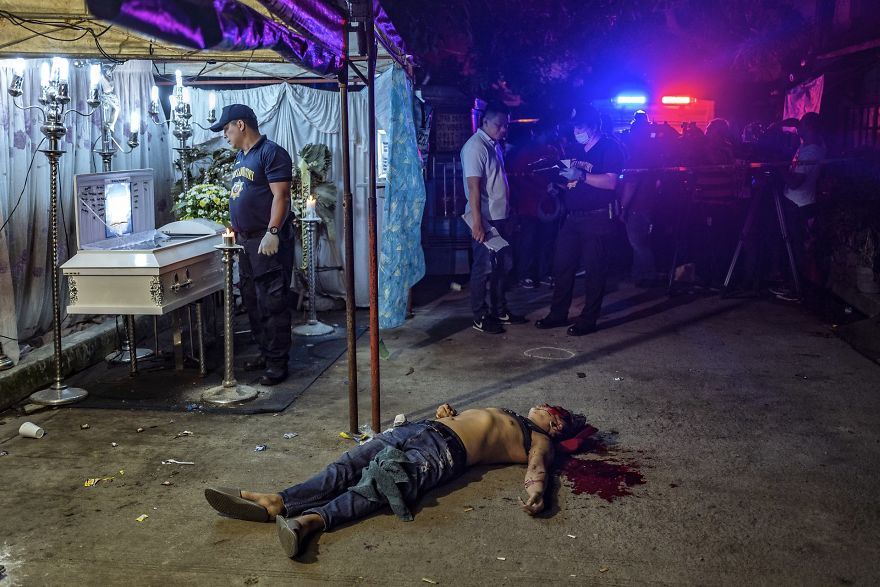
Image credits: Ezra Acayan
The body of Michael Nadayao lies in the street after he was shot dead by unidentified men in front of mourners at a wake, in Quezon City, Philippines, on 31 August.
President Rodrigo Duterte began a concerted anti-drug offensive soon after taking office in June 2016, repeatedly ordering increased attacks against suspects. Amnesty International reports that this led to human rights violations, including extrajudicial killings by both civilians and police. A spokesman for the Philippine Drug Enforcement Agency said the campaign had led to 5,050 deaths by December 2018, with Human Rights Watch citing over 12,000. In June, 38 UN member states called on President Duterte to end the killings and probe the causes of the drug war.
Spot News, Singles, 3rd Prize, “Climbing the Border Fence” by Pedro Pardo
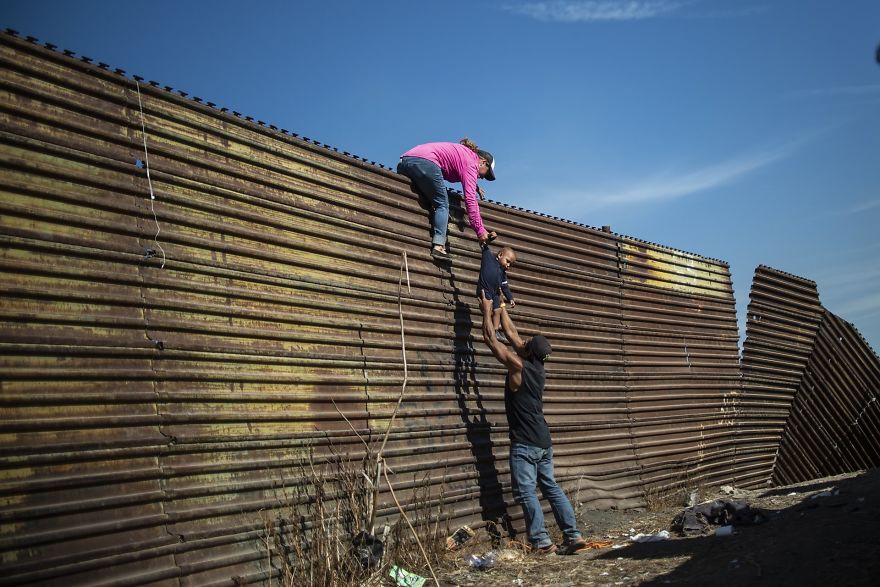
Image credits: Pedro Pardo
Central American migrants climb the border fence between Mexico and the United States, near El Chaparral border crossing, Tijuana, Baja California, Mexico.
Refugees who were part of a caravan that originated in Honduras in October, began arriving at the border in November to find a backlog of some 3,000 people waiting to be processed into the United States, and a potential delay of months. This led to rising tensions, and to people breaking away from the caravan to attempt their own entry.
Spot News, Stories, 1st Prize, “The Migrant Caravan” by Pieter Ten Hoopen

Image credits: www.worldpressphoto.org
During October and November, thousands of Central American migrants joined a caravan heading to the United States border. The caravan, assembled through a grassroots social media campaign, left San Pedro Sula, Honduras, on 12 October, and as word spread drew people from Nicaragua, El Salvador and Guatemala. They were a mix of those facing political repression and violence, and those fleeing harsh economic conditions in the hope of a better life. Traveling in a caravan offered a degree of safety on a route where migrants have previously disappeared or been kidnapped, and was an alternative to paying high rates to people smugglers. Migrant caravans travel to the US border at different times each year, but this was the largest in recent memory with as many as 7,000 travelers, including at least 2,300 children, according to UN agencies. Conditions along the way were grueling, with people walking around 30 km a day, often in temperatures above 30°C. The caravan usually set off at around 4am each day to avoid the heat. Like others, the caravan drew condemnation from US president Donald Trump, who made it a focal point of rallies and used it to reiterate his call for tough immigration policies and the building of a border wall.
Spot News, Stories, 2nd Prize, “Syria, No Exit” by Mohammed Badra
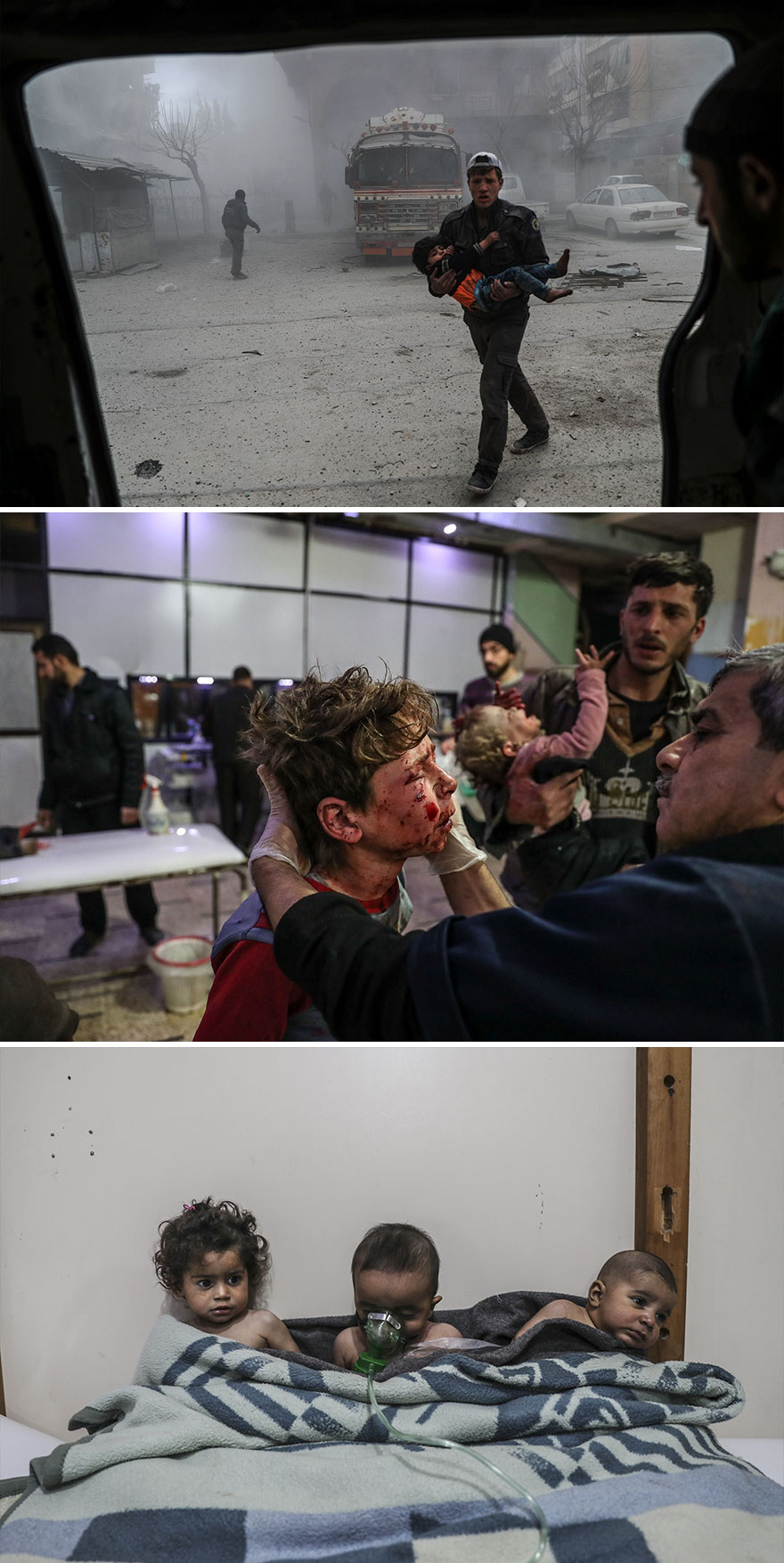
Image credits: www.worldpressphoto.org
By February 2018, the people of Eastern Ghouta, a suburban district outside Damascus and one of the last rebel enclaves in the ongoing Syrian conflict, had been under siege by government forces for five years. During the final offensive, Eastern Ghouta came under rocket fire and air bombardment, including at least one alleged gas attack—on the village of al-Shifunieh, on 25 February. Figures are difficult to verify, but Médecins Sans Frontiѐres (MSF) reported 4,829 wounded and 1,005 killed between 18 February and 3 March, according to data from medical facilities they supported alone. MSF also reported 13 hospitals and clinics damaged or destroyed in just three days. Reports on the end of the siege in Eastern Ghouta are conflicting, though the Syrian army appear to have recaptured most of the south of the country by July. UNICEF reported the siege of Eastern Ghouta to have ended by late March, with limited humanitarian access becoming available.
Spot News, Stories, 3rd Prize, “Ambulance Bomb” by Andrew Quilty

Image credits: Andrew Quilty
An ambulance packed with explosives killed 103 people and injured 235 in Kabul, Afghanistan, on 27 January. The ambulance had passed through one security point unnoticed, but although the attacker was identified at a second checkpoint, he couldn’t be stopped from detonating his explosives. The bombing took place at lunchtime near Chicken Street, a central shopping area once popular among foreign nationals, and close to government and diplomatic buildings. The victims, however, were overwhelmingly Afghan civilians and police. The Taliban claimed responsibility for the ambulance bombing, which ranked among the worst civilian attacks in the Afghan capital in some years. Taliban commanders said they were intensifying urban attacks in retaliation for increased airstrikes on areas under their control.
from Bored Panda http://bit.ly/2Ieg1RF

